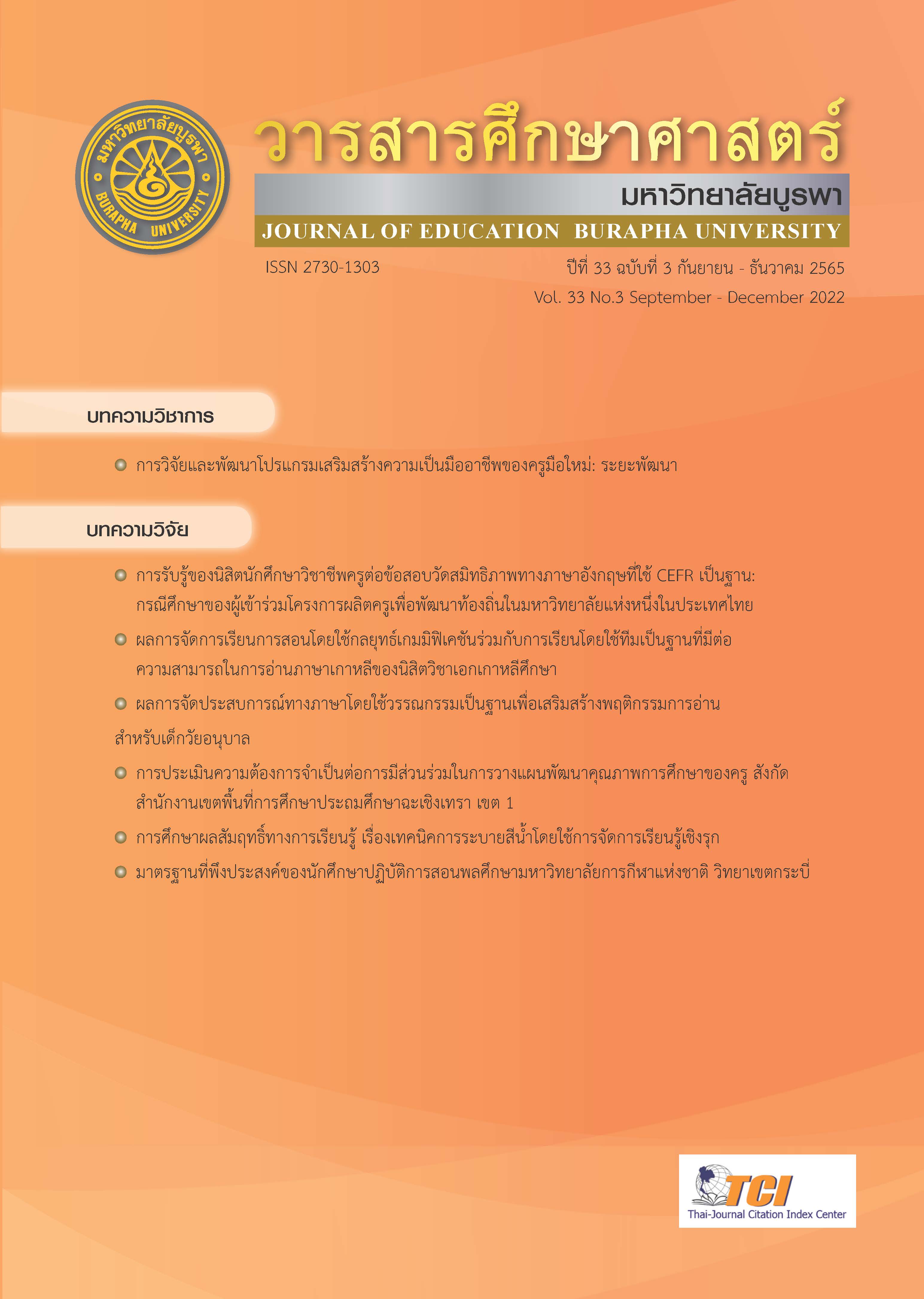การวิจัยและพัฒนาโปรแกรมเสริมสร้างความเป็นมืออาชีพของครูมือใหม่: ระยะพัฒนา
Research and Development of a Program to Enhance the Professionalism of Novice Teachers: A Development Phase
คำสำคัญ:
การพัฒนาวิชาชีพครู ครูมืออาชีพ ครูมือใหม่ การพัฒนาโปรแกรมฝึกอบรมบทคัดย่อ
การวิจัยนี้มีวัตถุประสงค์เพื่อพัฒนาโปรแกรมเสริมสร้างความเป็นครูมืออาชีพของครูมือใหม่ สำหรับนักศึกษาของคณะครุศาสตร์ มหาวิทยาลัยราชภัฏสวนสุนันทา โดยวิธีดำเนินการวิจัยและพัฒนาที่มีการใช้ข้อมูลพื้นฐานจากการประเมินความต้องการจำเป็นของนักศึกษาครูผู้ผ่านการฝึกประสบการณ์วิชาชีพในสถานศึกษาเป็นเวลาหนึ่งปีป้อนเข้าสู่ระยะพัฒนาโครงสร้างของโปรแกรม ซึ่งใช้วิธีอภิปรายกลุ่มเฉพาะโดยมีกลุ่มตัวอย่างเป้าหมายการวิจัยเป็นผู้ทรงคุณวุฒิ จำนวน 7 คน และการประเมินคุณภาพโครงสร้างของโปรแกรมด้วยแบบประเมินที่ผ่านการพัฒนาคุณภาพด้านความตรง โดยผู้ทรงคุณวุฒิ จำนวน 5 คน การเลือกกลุ่มตัวอย่างผู้ทรงคุณวุฒิใช้วิธีเลือกแบบเจาะจงตามคุณสมบัติ ได้แก่ (1) ผู้เชี่ยวชาญเฉพาะด้านทางการพัฒนานักศึกษาครู ผู้มีประสบการณ์การปฏิบัติงานอย่างน้อย 5 ปี (2) ครูประจำการของสถานศึกษาขั้นพื้นฐาน ผู้ที่มีประสบการณ์การสอนไม่ต่ำกว่า 10 ปี และ (3) ผู้เชี่ยวชาญด้านการพัฒนาหลักสูตรและการจัดการเรียนรู้
ผลการวิจัย พบว่า โครงสร้างสำคัญของโปรแกรม ประกอบด้วย จุดมุ่งหมาย 7 ข้อ ด้านเนื้อหา ได้แก่ รูปแบบการจัดการเรียนการสอนตามศาสตร์การสอน การออกแบบการเรียนการสอนที่เน้นผู้เรียนเป็นสำคัญ เทคนิคการบริหารจัดการชั้นเรียน การสร้างและพัฒนานวัตกรรมการเรียนการสอนที่เน้นผู้เรียนเป็นสำคัญ เทคนิควิธีการแลกเปลี่ยนเรียนรู้ตามแนวคิดเชิงพัฒนา (growth mindset) และหลักจริยธรรมและจรรยาบรรณสำหรับครู ด้านแนวการจัดกิจกรรมการอบรม แบ่งเป็น 3 ขั้น ได้แก่ ขั้นสั่งสมและสืบสวนองค์ความรู้ที่จำเป็น ขั้นการฝึกฝนทักษะ และขั้นสร้างสรรค์นวัตกรรม โดยมีกิจกรรมที่ประกอบด้วย การบรรยาย อภิปราย และศึกษากรณีตัวอย่าง การฝึกปฏิบัติ และการแสดงบทบาทสมมุติ จำนวนเวลาที่ใช้ในการพัฒนาประกอบด้วยเวลาการรับการอบรมภาคทฤษฎี ประมาณ 14 ชั่วโมง และภาคปฏิบัติใช้เวลาระหว่างการฝึกปฏิบัติการสอนในสถานศึกษา ประมาณ 4 สัปดาห์ ผลการประเมินคุณภาพโครงสร้างของโปรแกรมโดยผู้ทรงคุณวุฒิ พบว่ามีคุณภาพโดยรวมและรายโครงสร้างในระดับดีมาก
เอกสารอ้างอิง
จิราภรณ์ เกตุแก้ว. (2559). การพัฒนาหลักสูตรฝึกอบรมเพื่อเสริมสร้างจิตสาธารณะ สำหรับนักศึกษา
คณะครุศาสตร์ มหาวิทยาลัยราชภัฏนครศรีธรรมราช. นครศรีธรรมราช: คณะครุศาสตร์
มหาวิทยาลัยราชภัฏนครศรีธรรมราช.
มนสิช สิทธิสมบูรณ์. (2561). การพัฒนาหลักสูตรเสริมสร้างสมรรถนะการวิจัยในชั้นเรียนสำหรับครูระดับ การศึกษาขั้นพื้นฐาน. วารสารศึกษาศาสตร์ มหาวิทยาลัยนเรศวร, 20(4), 157-165.
วิจารณ์ พานิช. (2562). วิธีสร้างการเรียนรู้เพื่อศิษย์ในศตวรรษที่ 21. กรุงเทพฯ: มูลนิธิสดศรีสฤษดิวงษ์.
Akiba, M. & Liang, G. (2016). Effects of teacher professional learning activities on student achievement growth. The Journal of Educational Research, 109(1):1-12 DOI: 10.1080/00220671.2014.924470
Allen, J. P., Gregory, A., Mikami, A. Y., Lun, J., Hamre, B. K., Pianta, R. C. (2013). Observations of effective teaching in secondary school classrooms: Predicting student achievement with the CLASS-S. School Psychology Review, 42, 76-98.
Armstrong, M. (2001). A hand book of human resources Practice. UK: Kogan Page.
Arthur, W., Bennett, W., Edens, P.S., & Bell, S.T. (2003). Effectiveness of training in organizations: A meta-analysis of design and evaluation features. Journal of Applied Psychology, 88, 234–245.
Bratton, J., and Gold, J. (2007). Human resource management: theory and practice (4thed.).
Houndmills: Macmillan.
Buharkova, O. V. & Gorshkova, E. G. (2007). Image of the leader: technology of creation and
promotion. Training programme. Saint-Peterburg.
Creemers, B., Kyriakides, L., Antoniou, P. (2013). Towards the Development of a Dynamic Approach to Teacher Professional Development. Teacher Professional Development for Improving Quality of Teaching. Retrieved from https://doi.org/10.1007/978-94-007- 5207-8_1
Esteve J.M., Franco S., Vera J.L. (1995). Profesores ante el cambio social. Barcelona:
Anthropos.
Finkelstein, M. A. (2011). Correlates of Individualism and Collectivism: Predicting Volunteer Activity. Social Behavior and Personality: An International Journal. 39(5): 597-606
DOI: 10.2224/sbp.2011.39.5.597
Gallagher, H. A., Arshan, N. & Woodworth, K. (2017). Impact of the National Writing Project's College-Ready Writers Program in High-Need Rural Districts. Journal of Research on Educational Effectiveness, 10(1), 570-595. DOI: 10.1080/19345747.2017.1300361
Huberman M. (1992). Teacher development and instructional mastery. In: Hargreaves A, Fullan M, editors. Understanding Teacher Development. NY: Longman Publishers.
Kim, S., Roza, M., Seidman, E. (2011). Improving 21st-century teaching skills: The key to effective 21st-century learners. Research in Comparative and International Education. 14 (1): 174549991982921. DOI: 10.1177/1745499919829214
Kleickmann, T., Richter, D., Kunter, M., Elsner, J., Besser, M., Krauss, S & Cheo, M. (2014). Content knowledge and pedagogical content knowledge in Taiwanese and German mathematics teachers. Teaching and Teacher Education, 46:115-126. DOI: 10.1016/j.tate.2014.11.004
Locke, E. A., & Latham, G. P. (2002). Building a practically useful theory of goal setting and task motivation: A 35 year-odyssey. American Psychologist, 57, 705–717.
Niazi, A. (2014). Training and development strategy and it’s role in organizational performance. MS Scholar, Iqra University Islamabad Campus, Pakistan, Journal of Public Administration and Governance. ISSN 2161-7104
May, H., Sirinides, P., Gray, A. & Goldsworthy, H. (2016). Reading Recovery: An Evaluation of the Four-Year i3 Scale-Up. CPRE Research Reports. Retrieved from
https://repository.upenn.edu/cpre_researchreports/81
Meyers, C.V., Molefe, A., Brandt, W.C., Zhu, B., & Dhillon, S., (2016). Impact Results of the eMINTS Professional Development Validation Study. Educational Evaluation and Policy Analysis, September 1. Retrieved from https://doi.org/10.3102/0162373716638446/
Noe, R. A. (2008). Employee training and development (4th ed.). Boston, MA: Irwin-McGraw.
Noe, R. A., & Colquitt J. A. (2002). Planning for training impact: Principles of training
effectiveness. In K. Kraiger (Ed.), Creating, implementing, and maintaining effective training and development: State-of-the-art lessons for practice (pp. 53–79). San Francisco, CA: Jossey-Bass.
Penuel, W. R., Gallagher, L. P., & Moorthy, S. (2011). Preparing teachers to design sequences of instruction in earth systems science: A comparison of three professional development programs. American Educational Research Journal, 48(4), 996-1025.
Polly, D., McGee, J., Wang, C., Martin, C., Lambert, R. & Pugalee, D.K. (2015). Linking professional development, teacher outcomes, and student achievement: The case of a learner- centered mathematics program for elementary school teachers. International Journal of Educational Research, 72(1), 26-37. Elsevier Ltd. Retrieved August 31, 2022 from https://www.learntechlib.org/p/203644/.
Roth, K.J., Wilson, C.D. Taylor, A.J. (2017). Comparing the Effects of Analysis-of-Practice and Content-Based Professional Development on Teacher and Student Outcomes in Science. American Educational Research Journal, December 25, 2018 https://doi.org/10.3102/0002831218814759
Surface, E. A. (2012). Training needs assessment: Aligning learning and capability with performance requirements and organizational objectives. In M. A. Wilson, W. Bennett, Jr., S. G. Gibson, & G. M. Alliger (Eds.), The handbook of work analysis: Methods, systems, applications and science of work measurement in organizations (pp. 437–462). Routledge/Taylor & Francis Group.
ดาวน์โหลด
เผยแพร่แล้ว
รูปแบบการอ้างอิง
ฉบับ
ประเภทบทความ
สัญญาอนุญาต
ลิขสิทธิ์ (c) 2022 สุชีรา มะหิเมือง มหาวิทยาลัยราชภัฏสวนสุนันทา

อนุญาตภายใต้เงื่อนไข Creative Commons Attribution-NonCommercial-NoDerivatives 4.0 International License.
บทความทุกบทความเป็นลิขสิทธิ์ของวารสารศึกษาศาสตร์ มหาวิทยาลัยบูรพา



